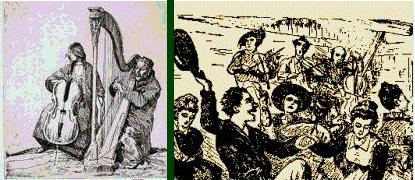On the esteemed Cellomania blog, PFS wrote “The more relaxed the shoulder, the better the tone. Maybe Terry could explain the physics behind that.” This was in a discussion that touched on keeping a lowered shoulder. Umm, thank for the vote of confidence, PFS (I think).
I can’t exactly explain it in such a rigorous and exacting manner that it would be published in a scientific journal, but I think I can explain it well enough that it makes intuitive sense. But keep in mind, two years ago I didn’t understand it. This was something that had to be demonstrated to me, physically, for me to get, mentally.
If I rest my hand on my trusty ol’ computer keyboard and raise my shoulder, what happens? I put a more downward pressure on the keyboard. Straight down. To a neophyte cellist, this seems like a good way to add a little so-called “weight” to a cello string, too. It’s so instinctual we tend to do it automatically, without even knowing it.
One of several problems with that instinct is that the string is not horizontal, but rather at a 45 degree angle or so. The force coming from a raised shoulder is straight down, rather than into the string. That straight down force doesn’t help the rosined hair help move the string sideways very well, and not only that, the straight down force interferes with the string’s sideway motion when the string slips from the rosin hair, giving us crunchy distortion.
If instead, we pull towards ourselves, something like what we would do rowing a boat, the force is more into the string, rather than down onto the string. We get freer sideways string motion. Not only that, but we can pull on that “oar” without stiffening our shoulder, arms, and wrist, allowing fluidity in strokes, bow changes, and string crossings.
So for me now, raising the shoulder when bowing a cello makes about as much sense as raising a shoulder when pulling on a boat oar. I'll bet not many people have a problem with a stiffened, tense shoulders when rowing a boat, even though they're putting a lot of force into it. Why? 'Cause they're too busy rowing! But then, what'ch y'all think?

Old World or New, Sacred or Profane
Monday, August 27, 2007
Basic Cello Chords
[Posted a few weeks ago on Cello Chat, re-posted here for archival/later reference]
The subject of playing chords like a guitar comes up once in a while. I've started a simple chord chart that still leaves much to be desired. I lifted the diagrams from a tenor banjo site. Tenor banjo is usually (but by no means always) tuned one octave higher than cello. Unfortunately, many fingering combinations that are easy on a small fretted banjo are just not practical on cello.
I only included the most common major and minor chords, with the root as lowest note, for jams and sing-alongs. That means some are three-string chords. I also omitted 7ths because the tenor banjo fingerings a that site were mostly impractical for cello, but it should be easy to figure out how to do a 7th from the major fingering.
Note that the numbers represent frets (ours are imaginary), not fingers. Mostly it's barred finger 1, 2 for minor/3 for major, and 4.
For the 4-string chords, often you can play the 7th with finger 2 on the A-string. For the 3-string chords, you can play the 7th with finger 4 on the D-string.

The subject of playing chords like a guitar comes up once in a while. I've started a simple chord chart that still leaves much to be desired. I lifted the diagrams from a tenor banjo site. Tenor banjo is usually (but by no means always) tuned one octave higher than cello. Unfortunately, many fingering combinations that are easy on a small fretted banjo are just not practical on cello.
I only included the most common major and minor chords, with the root as lowest note, for jams and sing-alongs. That means some are three-string chords. I also omitted 7ths because the tenor banjo fingerings a that site were mostly impractical for cello, but it should be easy to figure out how to do a 7th from the major fingering.
Note that the numbers represent frets (ours are imaginary), not fingers. Mostly it's barred finger 1, 2 for minor/3 for major, and 4.
For the 4-string chords, often you can play the 7th with finger 2 on the A-string. For the 3-string chords, you can play the 7th with finger 4 on the D-string.
Subscribe to:
Posts (Atom)